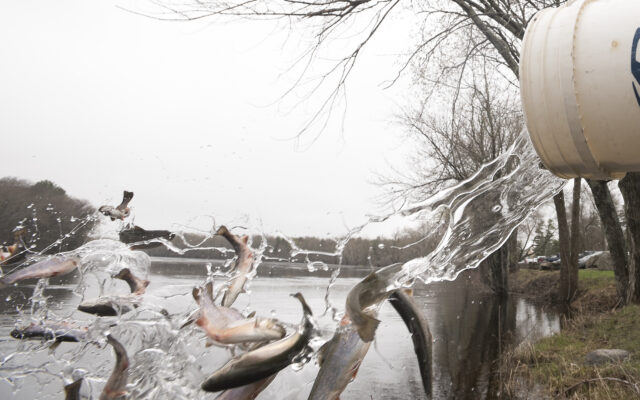
I think this is the real cost of the state’s trout stocking program
By Bob Mallard
A recent bill to increase fishing license fees to raise more money for hatcheries got a lot of people talking. Is this what Maine should be promoting? Is stocking the best use of our limited funds?
During public hearings, some said that anglers want, and in fact expect, more and bigger stocked trout. Are we obligated to provide this? Can we afford to do so? Who should pay for these fish?
Stocking is rooted in the belief that trout should be unlimited. How did we get to the point where stocked fish are so universally accepted by trout anglers? We stock waters where trout can’t survive for more than a couple of weeks due to warm water. We stock trout on top of bass and pike.
The trend is to invest more money in hatchery infrastructure and staffing. In 2021, Gov. Mills allocated $20 million from the Maine Jobs and Recovery Plan to hatchery improvements. Should non-fishers have been required to foot the bill? Was that the best use of these funds?
The Maine Department of Inland Fisheries and Wildlife’s Fisheries Division gets funding from multiple sources. This includes fishing license sales, Maine’s sportsman’s license plate, state General Fund ($3.5 million to $4.5 million per year,) federal excise tax levied on fishing gear and motorboat fuel, miscellaneous federal, state and private grants, and gifts and donations.
“Approximately 50 percent of all available funding supports hatchery operations and the other half supports all other [Fisheries] Division operations,” according to DIF&W. “At the core of Maine’s fisheries is Maine’s state hatchery system, which stocks over one million fish annually into Maine’s waters.”
The department’s website provides daily stocking updates to let people know the most recent releases of fish.
The core of Maine’s fisheries is our wild fish, especially our wild native fish. Rather than promoting what everyone else has, DIF&W should promote what very few others have.
Maine stocked 936,725 fish in 2024, according to DIF&W. The most frequently stocked species was brook trout at 66 percent of the total. Nonnative brown trout were second at 19 percent. Landlocked salmon were next at 8 percent. The remaining were rainbow trout, splake, and lake trout.
Trout are stocked in the spring and fall. There are five primary age groups: Fry at 3 inches long; fall fingerling at 7-8 inches, spring yearling at 9-10 inches and falling yearling at 12-14 inches.
The most frequently stocked age of brook trout in 2024 were spring yearlings at 52 percent of the total stocking events. Fall yearling were second at 24 percent and fall fingerlings were third at 16 percent.
As for the actual numbers of fish stocked, 41 percent were spring yearlings, 33 percent were fall fingerlings and 16 percent were fall yearlings.
The cost to raise brook trout is based on how long they are in the hatchery. Fry cost 5 cents each, fall fingerlings cost $1.44 each, spring yearlings cost $3.44 each and fall yearlings cost $9.12. The $5.68 difference between spring and fall yearlings is the result of five more months in the hatchery.
I tracked the cost-per-stocked-fish from 2004 through 2008. While the numbers fluctuated from one year to the next, they averaged 5 cents for fry, $1.02 for fall fingerlings, $2.40 for spring yearlings and $6.07 for fall yearlings.
By 2024, while the cost to raise fry remained more or less unchanged, the cost per fish had risen to $1.44 for fall fingerlings, $3.44 for spring yearlings, and $9.12 for fall yearlings. This represents an increase of approximately 30 percent.
Spring yearlings accounted for just more than 41 percent of the total cost in 2024, with fall yearlings coming in at roughly 41 percent and fall fingerlings around 16 percent of the total.
Based on a $25 resident fishing license, an angler consumes more than they pay for after harvesting just eight spring yearling brook trout. With a five-fish daily limit on many waters, that is not hard to do. As for fall yearlings, that number drops to just three fish.
Under the proposed $30 for a resident fishing license in 2026, an angler consumes more than they pay for after harvesting just nine spring yearlings, four fall yearlings or some combination of the two.
Money spent on stocking takes away from restoration, reclamation and other things that promote wild fish. In many cases, the impact is double because there are numerous grants for wild fish that require matching funds.
Increasing stocking is the opposite of what Maine should be doing. When you have what Maine has in regard to wild native fish, that is where the focus should be.
Trout stocking is an economic black hole. The cost to raise fish continues to go up. The belief that trout should be unlimited is flawed economically and ecologically. It’s time to reduce stocking, not increase it.
The DIF&W has the authority, and I believe responsibility, to do this.
Mallard is the former owner of Kennebec River Outfitters and a Registered Maine Fishing Guide. He is writer, author and executive director for Native Fish Coalition. Look for Bob’s latest books, Squaretail: The Definitive Guide to Brook Trout and Where to Find Them, Favorite Flies for Maine: 50 Essential Patterns from Local Experts, and Fly Fishing Maine: Local Experts on The State’s Best Waters. Mallard can be reached at BobMallard.com or Info@BobMallard.com.